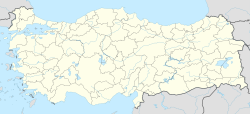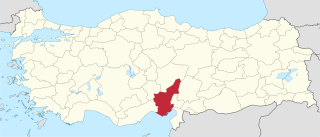
Adana Province is a province of Turkey located in central Cilicia. With a population of 2.20 million, it is the sixth most populous province in Turkey. The administrative seat of the province is the city of Adana, home to 79% of the residents of the province. It is also closely affiliated with other Cilician provinces of Mersin, Osmaniye, and Hatay.
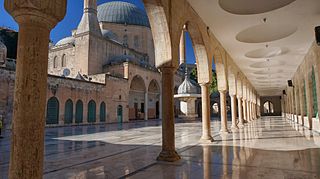
Urfa, officially known as Şanlıurfa, is a city with a population of over 2 million residents in southeastern Turkey, and the capital of Şanlıurfa Province. Urfa has a mix of Turkish, Kurdish, and Arab population. Urfa is situated on a plain about 80 km east of the Euphrates River. Its climate features extremely-hot, dry summers and cool, moist winters.

Turkey is divided into 81 provinces. Each province is divided into a number of different districts. Each provincial government is seated in the central district. For non-metropolitan municipality designated provinces, the central district bears the name of the province.

Karabük Province is a landlocked province in the northern part of Anatolia, located about 200 km (124 mi) north of Ankara, 115 km (71 mi) away from Zonguldak and 113 km (70 mi) away from Kastamonu. In 2010 it had a population of 227,610. The main city is Karabük which is located about 100 km (62 mi) south of the Black Sea coast.

Gaziantep, previously and still informally called Aintab or Antep, is the capital of Gaziantep Province, in the westernmost part of Turkey's Southeastern Anatolia Region, approximately 185 kilometres (115 mi) east of Adana and 97 kilometres (60 mi) north of Aleppo, Syria. It is thought to be located on the site of ancient Antiochia ad Taurum, and is near ancient Zeugma.
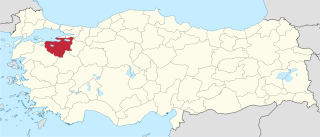
Bursa Province is a province in Turkey along the Sea of Marmara coast in northwestern Anatolia. It borders Balıkesir to the west, Kütahya to the south, Bilecik and Sakarya to the east, Kocaeli to the northeast and Yalova to the north. The province has an area of 11,043 km2 and a population of 2,994,521 as of 2018. Its traffic code is 16.
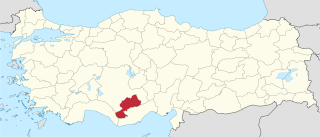
Karaman Province is a province of south-central Turkey. It has an area of 9,163 km2. It has a population of 232,633. According to the 2000 census the population was 243,210. Population density is 27.54 people/km2. The traffic code is 70. The capital is the city of Karaman. Karaman was the location of the Karamanid Beylik, which came to an end in 1486.

Adıyaman Province is a province in the Southeastern Anatolia Region of Turkey. The capital is Adıyaman.

Manisa Province is a province in western Turkey. Its neighboring provinces are İzmir to the west, Aydın to the south, Denizli to the southeast, Uşak to the east, Kütahya to the northeast, and Balıkesir to the north. The city of Manisa is the seat and capital of the province. The traffic code is 45.

Niğde Province is a province in the southern part of Central Anatolia, Turkey. Population is 341,412 of which 141,360 live in the city of Niğde. The population was 348,081 in 2000 and 305,861 in 1990. It covers an area of 7,312 km2. Neighbouring provinces are Kayseri, Adana, Mersin, Konya, Aksaray and Nevşehir.

Beypazarı is a Turkish town and district of Ankara Province in the Central Anatolia region of Turkey, approximately 100 km west of the city of Ankara. According to the 2000 census, the population of the district is 46,493, of which 35,775 live in the town of Beypazarı. The district covers an area of 1,814 km2 (700 sq mi), and the average elevation in the center is 675 m (2,215 ft). The district contains three other small towns and 64 villages. It used to be an important city in Asia Minor in ancient times.
A village is the smallest settlement unit in Turkey.

The siege of Kobanî was launched by the Islamic State of Iraq and the Levant on 13 September 2014, in order to capture the Kobanî Canton and its main city of Kobanî in northern Syria, in the de facto autonomous region of Rojava.

Kobanî, officially Ayn al-Arab, is a Kurdish-majority city in northern Syria, lying immediately south of the Syria–Turkey border. As a consequence of the Syrian civil war, the city came under the control of the Kurdish-majority People's Protection Units (YPG) militia in 2012 and became the administrative center of the Kobani Canton, later transformed into Euphrates Region of the Autonomous Administration of North and East Syria.

The Tell Abyad offensive or Martyr Rubar Qamışlo operation was a military operation that began in late May 2015 in the northern Raqqa Governorate, during the Syrian Civil War. It was conducted by the Kurdish-majority People's Protection Units (YPG) and the Free Syrian Army (FSA) against the Islamic State of Iraq and the Levant. The offensive took place from the end of May until July 2015. The campaign was the second phase of the Kurdish Operation Commander Rûbar Qamishlo, which began with the Al-Hasakah offensive, and involved the merger of the Kobanî offensive with the former. The focus of the campaign was to capture the key border town of Tell Abyad, and to link the Kobanî and Jazira Cantons in Northern Syria.

The Kobanî massacre was a combination of suicide missions and attacks on Kurdish civilians by the Islamic State of Iraq and the Levant on the Kurdish-held city of Kobanî, beginning on Thursday, 25 June, and culminating on Friday, 26 June 2015. The attacks continued into 28 June, with the last remaining ISIL militant being killed on the following day. The attacks resulted in 223–233 civilians dead, as well as 35–37 Kurdish militiamen and at least 79 ISIL assailants. It was the second-largest massacre committed by ISIL since it declared a caliphate in June 2014.

The Manbij offensive, code-named Operation Martyr and Commander Faysal Abu Layla by the SDF, was a 2016 military offensive operation by the Syrian Democratic Forces (SDF) to capture the city of Manbij from the Islamic State of Iraq and the Levant (ISIL), and eventually, the ISIL-held areas through Al-Bab to Herbel, in the area referred to as the "Manbij Pocket" in the northern Aleppo Governorate. The main goal of the offensive was to cut off ISIL's last supply routes from Turkey, and to prevent ISIL fighters from escaping across the Syria-Turkey border. For the first five days of the offensive, the US-led coalition conducted over 55 airstrikes in support of the SDF. After capturing Manbij city on 12 August, the SDF announced that the offensive would continue until the whole countryside around Manbij was captured, though the offensive effectively ended shortly after the Turkish Armed Forces initiated Operation Euphrates Shield to prevent the SDF uniting the regions of Rojava.

The Battle of al-Bab was a battle for the city of al-Bab in the Aleppo Governorate that included a military offensive launched by Syrian rebel groups and the Turkish Armed Forces north of al-Bab, a separate Syrian Democratic Forces (SDF) offensive east and west of the city, and another Syrian Army offensive from the south of the city. The northern Turkish-led forces intended to capture al-Bab from the Islamic State of Iraq and the Levant (ISIL), as part of the Turkish military intervention in Syria. By the end of the battle, the Turkish-led forces had captured al-Bab, Qabasin, and Bizaah, while the Syrian Army captured Tadef and other areas further south, with the SDF making gains further to the east and the west.

The East Aleppo offensive (2017), also referred to as the Dayr Hafir offensive, was an operation launched by the Syrian Army to prevent Turkish-backed rebel forces from advancing deeper into Syria, and also to ultimately capture the ISIL stronghold of Dayr Hafir. Another aim of the operation was to gain control of the water source for Aleppo city, at the Khafsa Water Treatment Plant, in addition to capturing the Jirah Military Airbase. At the same time, the Turkish-backed rebel groups turned towards the east and started launching attacks against the Syrian Democratic Forces, west of Manbij.
